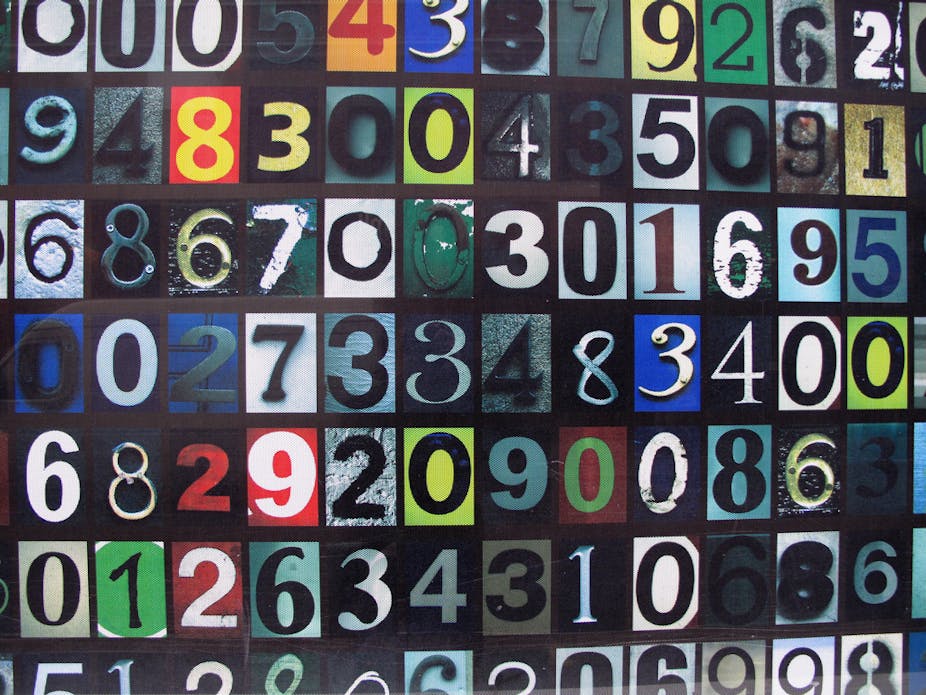While adding up your grocery bill in the supermarket, you’re probably not thinking how important or sophisticated our number system is.
But the discovery of the present system, by unknown mathematicians in India roughly 2,000 years ago – and shared with Europe from the 13th century onwards – was pivotal to the development of our modern world.
Now, what if our “decimal” arithmetic, often called the Indo-Arabic system, had been discovered earlier? Or what if it had been shared with the Western world earlier than the 13th century?
First, let’s define “decimal” arithmetic: we’re talking about the combination of zero, the digits one through nine, positional notation, and efficient rules for arithmetic.
“Positional notation” means that the value represented by a digit depends both on its value and position in a string of digits.
Thus 7,654 means:
(7 × 1000) + (6 × 100) + (5 × 10) + 4 = 7,654
The benefit of this positional notation system is that we need no new symbols or calculation schemes for tens, hundreds or thousands, as was needed when manipulating Roman numerals.
While numerals for the counting numbers one, two and three were seen in all ancient civilisations – and some form of zero appeared in two or three of those civilisations (including India) – the crucial combination of zero and positional notation arose only in India and Central America.
Importantly, only the Indian system was suitable for efficient calculation.
Positional arithmetic can be in base-ten (or decimal) for humans, or in base-two (binary) for computers.
In binary, 10101 means:
(1 × 16) + (0 × 8) + (1 × 4) + (0 × 2) + 1
Which, in the more-familiar decimal notation, is 21.
The rules we learned in primary school for addition, subtraction, multiplication and division can be easily extended to binary.
The binary system has been implemented in electronic circuits on computers, mostly because the multiplication table for binary arithmetic is much simpler than the decimal system.
Of course, computers can readily convert binary results to decimal notation for us humans.
As easy as counting from one to ten
Perhaps because we learn decimal arithmetic so early, we consider it “trivial”.
Indeed the discovery of decimal arithmetic is given disappointingly brief mention in most western histories of mathematics.
In reality, decimal arithmetic is anything but “trivial” since it eluded the best minds of the ancient world including Greek mathematical super-genius Archimedes of Syracuse.
Archimedes – who lived in the 3rd century BCE – saw far beyond the mathematics of his time, even anticipating numerous key ideas of modern calculus. He also used mathematics in engineering applications.
Nonetheless, he used a cumbersome Greek numeral system that hobbled his calculations.
Imagine trying to multiply the Roman numerals XXXI (31) and XIV (14).
First, one must rewrite the second argument as XIIII, then multiply the second by each letter of the first to obtain CXXXX CXXXX CXXXX XIIII.
These numerals can then be sorted by magnitude to arrive at CCCXXXXXXXXXXXXXIIII.
This can then be rewritten to yield CDXXXIV (434).
(For a bit of fun, try adding MCMLXXXIV and MMXI. First person to comment with the correct answer and their method gets a jelly bean.)
Thus, while possible, calculation with Roman numerals is significantly more time-consuming and error prone than our decimal system (although it is harder to alter the amount payable on a Roman cheque).
History lesson
Although decimal arithmetic was known in the Arab world by the 9th century, it took many centuries to make its way to Europe.
Italian mathematician Leonardo Fibonacci travelled the Mediterranean world in the 13th century, learning from the best Arab mathematicians of the time. Even then, it was several more centuries until decimal arithmetic was fully established in Europe.
Johannes Kepler and Isaac Newton – both giants in the world of physics – relied heavily on extensive decimal calculations (by hand) to devise their theories of planetary motion.
In a similar way, present-day scientists rely on massive computer calculations to test hypotheses and design products. Even our mobile phones do surprisingly sophisticated calculations to process voice and video.
But let us indulge in some alternate history of mathematics. What if decimal arithmetic had been discovered in India even earlier, say 300 BCE? (There are indications it was known by this date, just not well documented.)
And what if a cultural connection along the silk-road had been made between Indian mathematicians and Greek mathematicians at the time?
Such an exchange would have greatly enhanced both worlds, resulting in advances beyond the reach of each system on its own.
For example, a fusion of Indian arithmetic and Greek geometry might well have led to full-fledged trigonometry and calculus, thus enabling ancient astronomers to deduce the laws of motion and gravitation nearly two millennia before Newton.
In fact, the combination of mathematics, efficient arithmetic and physics might have accelerated the development of modern technology by more than two millennia.
It is clear from history that without mathematics, real progress in science and technology is not possible (try building a mobile phone without mathematics). But it’s also clear that mathematics alone is not sufficient.
The prodigious computational skills of ancient Indian mathematicians never flowered into advanced technology, nor did the great mathematical achievements of the Greeks, or many developments in China.
On the other hand, the Romans, who were not known for their mathematics, still managed to develop some impressive technology.
But a combination of advanced mathematics, computation, and technology makes a huge difference.
Our bodies and our brains today are virtually indistinguishable from those of ancient times.
With the earlier adoption of Indo-Arabic decimal arithmetic, the modern technological world of today might – for better or worse – have been achieved centuries ago.
And that’s something worth thinking about next time you’re out grocery shopping.
This article was adapted from a longer piece written by Jon and David for their blog: Math Drudge.

